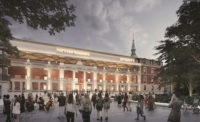EMBT Designs Zhang Da Qian Museum in Neijiang












| Image courtesy EMBT |
|
EMBT Designs Zhang Da Qian Museum in Sichuan Province. Click to view more images. |
Construction will start this year on a museum dedicated to the work of artist Zhang Da Qian. Located in Neijiang, in Sichuan Province, the project was designed by Benedetta Tagliabue, head of the Barcelona studio Miralles Tagliabue EMBT.
Zhang Da Qian was born in Nejiang in 1899. Although he left China in 1948, never to return, he is avidly collected in China, and is one of several artists credited with bringing traditional Chinese painting into the 20th century. He was the world's top-selling artist at auction houses last year with over $500 million in sales, unseating Picasso for the first time in 14 years, according to the magazine Artinfo.
The museum is a gift to Neijiang by another native son, Li Xioping, president of Excellence Group, a real estate developer. He contacted EMBT after seeing the firm's much-admired Spanish Pavilion at the 2010 Expo in Shanghai.
Like the Expo project—a basket-like structure of woven bamboo—the museum combines elements from traditional Chinese culture with contemporary strategies such as collage and the transformation of found material. On a wooded mountain peak overlooking the city—a setting evocative of Chinese landscape painting, and a favorite lookout for Neijiang's 1.2 million residents—EMBT grouped five pavilions around an existing teahouse, in a setting of gardens, terraces and walks. The Spanish firm, which has a Shanghai office, is developing the project in collaboration with architects from Tongji University in Shanghai, its local partners on the Expo building.
The five pavilions at the Zhang Da Qian Museum will be connected by floating walkways reminiscent of those in traditional Chinese gardens, according to Daniel Rosselló, EMBT's director of projects. Each pavilion is an irregular ovoid formed by bamboo-covered steel fins and solid or transparent infill panels. At the top of the pavilion, a skylight fills the space inside a tension ring connecting the fins. The steel profiles "work as structure and support for exhibits, and provide shade," Rosselló explains.
The museum does not own any work by Zhang, so its program was originally dedicated simply to presenting his life story, illustrated with reproductions. But worldwide interest in the project has opened the door to loans of actual works from private collectors, and the architects have redesigned two of the pavilions to meet international standards for art conservation, eliminating glass and introducing sophisticated climate control systems. Other pavilions will be dedicated to a bookshop, a workshop on bonsais (one of the artist's interests), and a studio that is part of a grant program for young artists. In these pavilions, faceted planes of glass between some of the fins will draw in northern light. The project includes a small auditorium, media library, café and VIP area.
Curiously, Picasso plays an important role in the design concept. Zhang and Picasso had a famous encounter in France in the 1950s, when they exchanged drawings as the reputed living masters of Eastern and Western art. Deepening this connection, Neijiang has established a sister-city relation with Málaga, Spain, Picasso's birthplace. EMBT used drawings the two artists exchanged as templates for the design, developing what Rosselló calls "the geometry of a friendship."
For the plan, Picasso's portrait of Zhang, his face surrounded by dashing blots of ink for hair and beard, inspired the layout for the pavilions' rings of structural fins. Zhang's traditional rendering of a grove of bamboo provided the concept for the pavilion's vertical development. The fins' irregular profiles, designed using folded and cut paper, derive from this drawing and other sources, including a photograph of the artist and his paintings of a woman and a mountain landscape. It also refers to a large boulder from his garden in Taiwan, which he brought from California, and under which he is buried.








